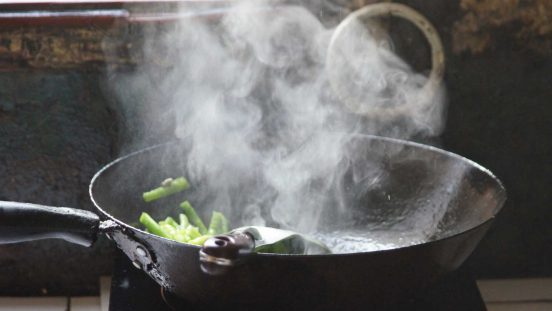If you know hardly anything about chile peppers, you know they are pungent. Hot.
The spiciness goes deeper, though… all the way to torture and war.
We won’t usually go that far in daily use, but it’s noticeable just from cooking with chilli that it can make you cough.
The hotter the pepper, the more intense the heat of the cooking, the greater the chances that the coughing will be hard.
Why do chile peppers make you cough, though?
The “Burn” of Chilli
By and by, the awareness that chilli pungency is not really a taste is spreading.
We taste what is sweet, sour, salty, bitter and umami in the mouth and especially on the tongue. Complex aromas are recognized when taste substances from food reach one’s nose.
When you complain that you cannot taste anything because you have a cold, the food actually doesn’t smell like anything to you.
Chilli does contribute such aromas, which should not be underestimated.
Its most memorable effect, of course, is the pungency… which is really a feeling of pain.
The same pain receptors in the mouth which react to temperatures that are too high also react to capsaicin. Or so goes the story which is often being told.

The TRPV1 Pain Alarm
The nociceptors (i.e., pain receptors) meant here are the TRPV1 receptors. Actually, just saying TRPV1 should be enough, as it stands for “Transient Receptor Potential Vanilloid 1.” It’s a mouthful, anyways…
There are actually a few such receptors or ion channels for transient receptor potentials. They can be found throughout the body and they fulfil various roles.
Let’s not get lost in any further details but stick with TRPV1 alone, though.
Where TRPV-1 Is Located
This ion channel lies in the membranes of mucosal cells.
Skin seems to have some such receptors – hence, why we can feel (some) chilli heat even on our fingers.
They are mainly located in mucosal cells, as just mentioned – and therefore, in mucosal membranes. From the oral and nasal cavity, mucous membranes extend into the lungs, and through the gastrointestinal tract.
What TRPV-1 Senses
TRPV-1 is a receptor for various dangerous things.
One of the first findings was that it reacts to high temperatures and/as (the associated) pain. But, it also gets activated by capsaicin (and resiniferatoxin) – or rather, by vanilloid sections on these substances (hence, why it is a vanilloid receptor).
By now, it is known that this receptor actually gets activated by various sensory inputs. These include temperatures above 43C, sour pH, irritant chemicals (like capsaicin), and more. Supposedly, it even gets irritated by small air pollution particles, the (in)famous pm2.5.
How Capsaicin Activation of TRPV-1 Works
Capsaicin and acids bind to the receptor and open the ion channel (activating the sensory signal) and/or make TRPV1 more sensitive.
The story with capsaicin, in particular, is that it makes this receptor so sensitive, it doesn’t signal when temperatures are above 43C anymore. Rather, the threshold for a signal from it is lowered to surrounding temperatures of 36C… human body temperature.
“Hot” Foods?
There is probably a relationship between this interplay of capsaicin, temperature, and pain in how spicy foods feel.
That is, maybe this is the reason why spicy dishes that are cold can feel somewhat warm, and hot dishes that are spicy feel rather spicier and hotter than they are.

Why Do We ‘Smell’ Capsaicin?
To explain how all that leads to coughing, we need to remember that TRPV1 receptors lie all the way into the lungs.
There, they serve to recognize and react to noxious influences and substances.
What’s the reaction to inhaling something (potentially) dangerous in breathing? Yup, coughing.
Cook That Capsaicin
While cooking with chilli, capsaicin apparently gets into the air. Between heat and (probably) especially well in the mix with cooking oil, that should work particularly well.
Burn a chilli, let alone put it into the microwave*, and capsaicin also gets transported in the air.
Inhale that, and… well.
Let’s just mention, at this point, that the activation of TRPV1 plays a role in lung diseases, all the way to COPD and asthma, as well as with inflammation… and inhaling a good dose of capsaicin is similarly not-nice.
Not that there would be immediate (lasting) issues from it.
(In fact, the role of TRPV1 in inflammation appears to be such that turning off this receptor leads to fewer negative health issues and longer lifespans – at least in mice.)
It is no fun, though.
There is a reason why people in Hunan love to cook outside on a balcony or, at the very least, in a kitchen that is well-ventilated to the outside and safely away from the other rooms, not part of a closed apartment!

*The thing about microwave ovens: Attempts at drying chilli in those (and even just attempts at cooking certain dishes which start by strongly frying chilli in a pan) have led to terror alarm and fire brigade “visits” with breathing apparatus. The microwave oven seems to be particularly good at transferring capsaicin straight into the air.
And yes, I can speak to that from personal experience. Only, luckily, in an otherwise empty house and without a visit from the fire brigade.
It all makes it eminently understandable how the Cuetlaxtlans could have used chilli to suffocate Aztec emissaries, and how “memorable” Aztec children’s punishment through the smoke of burning chilli must have been!

Leave a Reply
You must be logged in to post a comment.